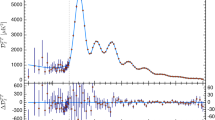Summary
The strong bursts of gravitational waves detected by Weber, if confirmed, suggest the presence in the Galaxy of arelativistic cluster of collapsed bodies which «burns» its own gravitational potential energy and slowly decays into a dead, collapsed object. We discuss the possibility of this being a common feature throughout the universe and consider a simple cosmological model in which the «missing mass» is attributed mainly to gravitational waves and dead, dark galaxies. The production of the former is described by a simple rate equation containing a characteristic frequency α. Using the known value of the Hubble constantH and the present visible mass density we find, when the efficiency of the process is, say, 0.5, α≈8H; the corresponding gravitational brightness of an average galaxy turns out to agree with Weber's figure (assuming a wide-band spectrum) to within a factor 2. This model features an isotropic cosmological background of gravitational waves, with energy density about 50 times smaller than the energy arriving from the galactic nucleus.
Riassunto
Gli intensi impulsi di onde gravitazionali rivelati da Weber, se confermati, suggeriscono la presenza nella Galassia di unammasso relativistico di corpi collassati che «brucia» la sua energia potenziale gravitazionale e decade lentamente in un solo oggetto inerte. Nel lavoro si esamina la possibilità che questo costituisca un fenomeno comune a tutto l'universo e si considera un semplice modello cosmologico in cui la «massa mancante» è attribuita principalmente a onde gravitazionali ed a galassie morte ed oscure. L'emissione delle prime è descritta da una semplice equazione di decadimento che contiene una frequenza caratteristica α. Usando i valori noti della costante di HubbleH e della massa visibile al presente troviamo, quando l'efficienza del processo è, diciamo, 0.5, α≈8H; lo splendore gravitazionale di una galassia in media si accorda con il risultato di Weber (nell'ipotesi di uno spettro a banda larga) entro un fattore 2. Questo modello prevede un fondo cosmologico e isotropo di onde gravitazionali, con densità di energia circa 50 volte più piccola di quella che ei giunge dal nucleo galattico.
Пезюме
Сильные импульсы гравитационных волн, обнаруженные Вебером, если они подтвердятся, свидетельствуют о наличии в центре Галактикирелямивисмского сгусмка коллапсирующих мел, которые «порождают» свою собственную гравитационную потенциальную энергию и медленно распадаются в мертвые, коллапсированные объекты. Мы обсуждаем возможность этого процесса, который является характерным для всей Вселенной, и рассматриваем простую космологическую модель, в которой «исчезающая масса» является, в основном, атрибутом гиавитационных волн и мертвых, черных Галактик. Рождение гравитационных волн описывается простым уравнением, содержащим характеристическую частоту α. Используя известную величину постоянной ХубблаH и современную наблюдаемую плотность массы, мы находим, что α≈8H, когда эффективность этого процесса составляет, скажем, 0.5. Оказывается, что соответствующая гравитационная яркость средней Галактики согласуется с результатом Вебера в пределах множителя 2 (если предположить широкополосный спектр). Эта модель описывает изотропный космологический фон гравитационных волн с плотностью энергии почти в 50 раз меньшей, чем энергия, приходящая из галактического ядра.
Similar content being viewed by others
References
J. Weber:Phys. Rev. Lett.,19, 498 (1967);22, 1320 (1969);24, 276 (1970);B. Braginski andYa. B. Zel'dovich:Sov. Phys. JETP Lett.,9, 437 (1969);V. B. Braginski andV. N. Rudenko:Sov. Phys. Uspekhi,13, 165 (1970).
G. B. Field, M. J. Rees andD. W. Sciama:Comm. Astrophys. Space Sci.,1, 187 (1969).
J. Weber:Phys. Rev. Lett.,25, 180 (1970).
G. Greenstein:Astrophys. Journ.,158, L145 (1969).
P. Kafka:Nature,226, 436 (1970);Mitteilungen der Astronomischen Gesellschaft, No. 27, p. 134 (1969); see alsoE. D. Fackerell, J. R. Ipser andK. S. Thorne:Comm. Astrophys. Space Sci.,1, 134 (1969).
Ya. B. Zel'Dovich andI. D. Novikov:Sov. Phys. Uspekhi,8, 522 (1965);F. J. Dyson:Comm. Astrophys. Space Sci.,1, 75 (1969);Ya. B. Zel'Dovich andM. A. Podurets:Sov. Astronomy Astrophys. Journ.,9, 742 (1966).
A. M. Wolfe andG. R. Burbidge:Astrophys. Journ.,161, 419 (1970).
D. W. Sciama:Nature,224, 1263 (1969);D. W. Sciama, G. B. Field andM. J. Rees:Phys. Rev. Lett.,23, 1514 (1969).
See,e.g., the article byG. de Vaucouleurs: inHandbuch der Physik, Vol.53 (Berlin, 1959);E. M. Burbidge andG. R. Burbidge:The masses of galaxies, inGalaxies and the Universe, edited byA. Sandage andM. Sandage, Vol.9 of the series on Stars and Stellar Systems, to be published by the University of Chicago Press.
Conference on the Instability of Systems of Galaxies, Astron. Journ.,66, 533 (1961); see also the article byE. M. Burbidge andG. R. Burbidge, quoted previously; see alsoS. van den Bergh:Nature,224, 891 (1969).
For a different interpretation of this mass defect, however, seeG. de Vaucouleurs:Science,167, 1203 (1970).
J. A. Wheeler:Rendiconti S.I.F., Course XI (New York, 1969), p. 113;L. Klauder jr.,R. Willey andJ. A. Wheeler: inLa structure et l'évolution de l'univers, Solvay Conference (Brussels, 1957).
P. Jordan:Schwerkraft und Weltall (Braunschweig, 1955), Sect.20.
P. J. E. Peebles:Astrophys. Journ.,154, L121 (1968).
q n≈1 is the traditional estimate based on the brightest galaxy of each cluster (seeW. A. Baum:I.A.U. Symposium, No. 15, edited byG. C. McVittie (New York, 1961), p. 390 and older papers), but the problem is now rapidly evolving with the addition of new data. No firm results are available yet, but the tendency is for lower values (J. V. Peach:Astrophys. Journ.,159, 753 (1970) and his review lectureCosmological information from galaxies and radio galaxies at theI.A.U. Symposium, No. 44 (Uppsala, 1970);J. E. Solheim andB. M. Tinsley:Analysis of the magnitude-redshift relation including possible effects of evolution, paper presented at the same symposium).
J. H. Oort: inLa structure et l'évolution de l'univers, Solvay Conference (Brussels, 1958), p. 163;J. H. Oort:Nature,224, 1158 (1969).
Author information
Authors and Affiliations
Additional information
Переведено редакцией.
Rights and permissions
About this article
Cite this article
Bertotti, B., Cavaliere, A. Gravitational waves and cosmology. Nuov Cim B 2, 223–235 (1971). https://doi.org/10.1007/BF02723085
Received:
Published:
Issue Date:
DOI: https://doi.org/10.1007/BF02723085



